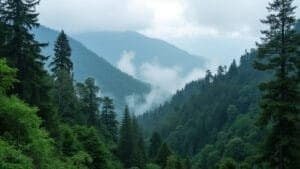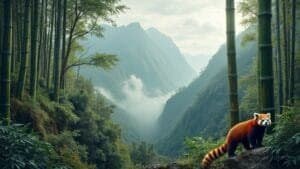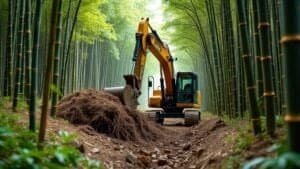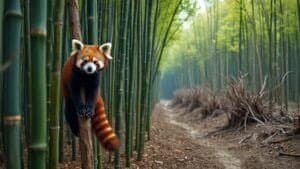The density of vegetation plays a critical role in shaping how red pandas navigate their mountainous forest habitats. So, how does the density of vegetation in red panda habitats influence their movement? As arboreal mammals dependent on dense bamboo understories and forest canopy, red pandas rely on thick vegetation for food, shelter, and safe passage
In this article, we explore how bamboo abundance, canopy coverage, and forest fragmentation affect their mobility, behavior, and energy expenditure. We’ll also look into how red pandas adapt their activity patterns in sparsely vegetated areas and highlight conservation practices that help maintain the vegetation structure essential for their survival
Impact of Vegetation Density on Red Panda Movement
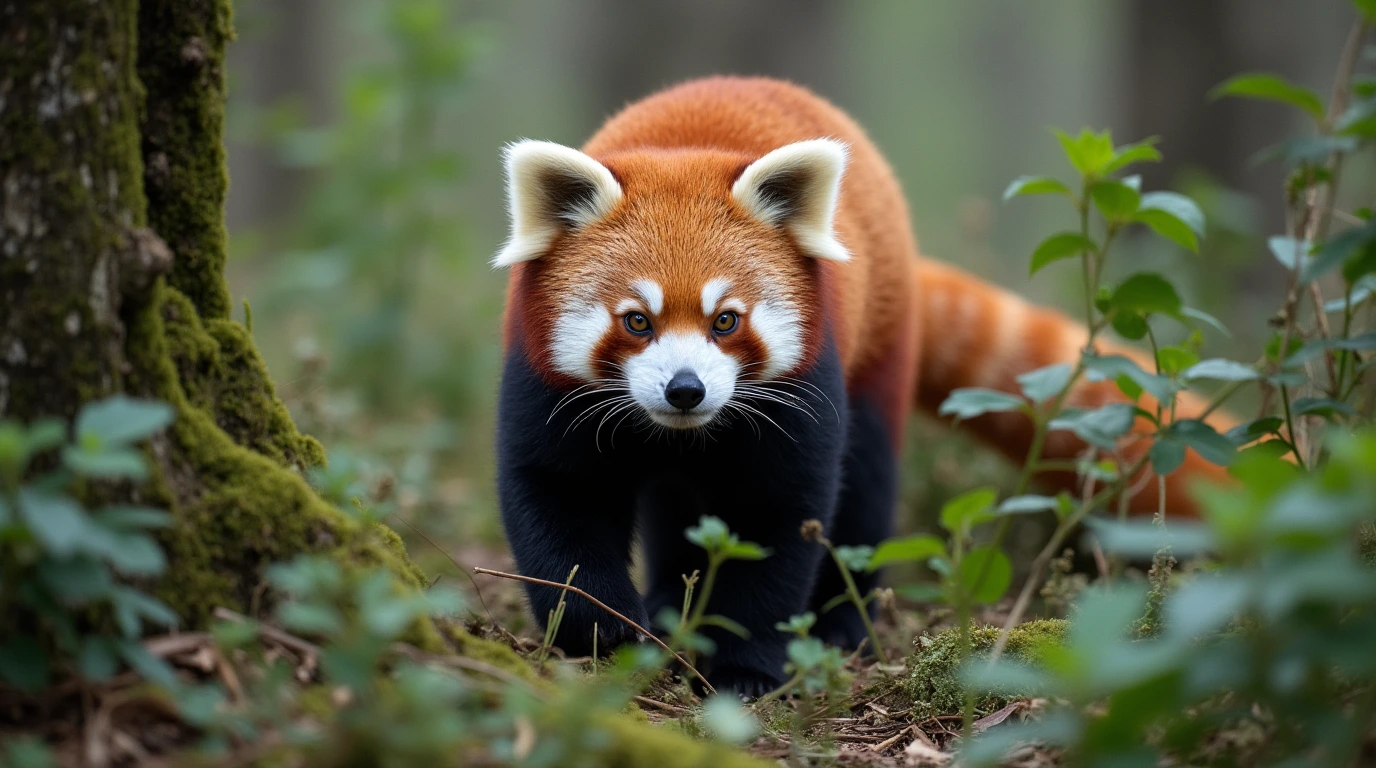
Red pandas are highly adapted to life in the forested mountain ranges of the Himalayas and southwestern China. As solitary, arboreal mammals, they depend on dense vegetation not only for food and shelter but also for safe and efficient movement through their habitat
The density of vegetation—including bamboo cover and forest canopy structure—has a direct impact on how red pandas travel, forage, and respond to environmental pressures. Understanding this relationship is essential for assessing habitat quality and ensuring the long-term survival of this endangered species
Vegetation Structures Favored by Red Pandas
Red pandas exhibit strong preferences for certain types of vegetation structure that facilitate their movement and support other vital behaviors. In particular, they are drawn to habitats characterized by a dense understory of bamboo and a closed forest canopy. According to a study published in Global Ecology and Conservation (Thapa et al., 2020), red pandas are more frequently found in areas where bamboo coverage exceeds 60% and canopy cover is above 30%
These conditions support their primary dietary needs, as bamboo accounts for over 90% of a red panda’s intake. Dense bamboo also offers ground-level shelter and visual cover from predators. Meanwhile, a connected canopy provides red pandas with the vertical continuity needed for arboreal travel, enabling them to move from tree to tree without descending to the forest floor, where they are more vulnerable
In regions with steep terrain, such as eastern Nepal or Bhutan’s temperate forests, red pandas often use sloped landscapes with thick moss-covered trees and undergrowth. These environments offer not only concealment but also the moisture retention necessary for bamboo growth and the preservation of other edible plants and lichens
Influence of Bamboo Abundance on Travel Behavior
The density and distribution of bamboo have a significant influence on red panda travel patterns. In habitats where bamboo is uniformly dense, red pandas show localized and energy-efficient movement. They tend to remain within small home ranges—averaging 1.6 to 3.5 square kilometers—where they can forage, rest, and nest with minimal movement. This behavior reduces energy expenditure and minimizes exposure to threats
Conversely, in areas with patchy or degraded bamboo cover, red pandas must expand their range and travel greater distances to find sufficient food. A 2019 study in Global Ecology and Conservation documented that in fragmented bamboo habitats, red pandas increased their movement by nearly 40% daily compared to individuals in contiguous, bamboo-rich forests
This extended movement not only drains energy but also increases exposure to risks such as predators, domestic dogs, and human activity. Moreover, long-distance movement across sparse bamboo zones often takes red pandas into suboptimal habitats, including agricultural edges or open forest gaps, where they are more vulnerable
Bamboo die-off events, which occur naturally every few decades, further complicate movement behavior. During such events, red pandas must often relocate to higher or lower elevations or move laterally across ridges to find viable bamboo stands. If vegetation corridors are not intact, these movements can lead to habitat abandonment or isolation
Role of Forest Canopy in Arboreal Navigation
The forest canopy serves as a critical highway for red pandas. A well-connected canopy structure enables them to move horizontally across trees, which is safer and more efficient than terrestrial travel. Dense canopies help them avoid ground-based predators like leopards and martens, and reduce encounters with humans and livestock
Scientific observations, including GPS tracking studies like the one published in Landscape Ecology (2021), confirm that red pandas spend a significant portion of their active hours in the mid-canopy layer. In dense forests, their movement is more direct and predictable, often following ridgelines or continuous canopy paths
In degraded habitats with broken canopy coverage, red pandas are forced to descend and traverse forest floors more frequently. This not only increases predation risk but also interrupts feeding and resting cycles, leading to increased stress and reduced fitness
In fact, canopy fragmentation has been linked to reduced use of high-quality habitat patches. Even if a patch contains sufficient bamboo, if it is isolated by open ground or canopy gaps, red pandas are less likely to use it, as reported in a Wildlife Biology (2023) study focusing on habitat selection and vegetation structure
For more in-depth information on how vegetation structure impacts red panda habitat preference and movement, you can consult this open-access research in Global Ecology and Conservation, which explores the relationship between vegetation density and space use patterns in wild red panda populations
Behavioral and Energetic Responses to Sparse Vegetation

When red pandas are confronted with sparsely vegetated environments, they respond with notable shifts in their movement patterns, behavior, and energy use. Vegetation density, or the lack thereof, not only alters how red pandas navigate their habitat but also influences their foraging efficiency, resting behavior, and vulnerability to external threats
These adaptations reflect the species’ attempt to survive in suboptimal or human-impacted environments, yet they also reveal the biological costs of habitat degradation
Activity Adjustments in Low-Vegetation Areas
In areas with low vegetation density, red pandas modify their daily routines to minimize risks associated with exposure. These behavioral changes include shifting movement to nighttime hours, reducing active periods during daylight, and avoiding open spaces, especially those near human settlements or roads. A 2021 movement ecology study using GPS tracking revealed that red pandas in fragmented or sparsely vegetated areas exhibited more nocturnal movement patterns than their counterparts in denser forests
This change in activity timing is believed to be a strategy to avoid predators and human disturbances, both of which are more prevalent during the day. However, this adjustment comes at a cost. Red pandas are naturally crepuscular—most active during dawn and dusk—so shifting to nocturnal activity may reduce foraging efficiency and alter their metabolic cycles
Additionally, in low-vegetation zones, red pandas were observed to increase their speed of movement and decrease their resting time, a behavioral signature of stress. Without adequate cover or feeding resources, they are forced to move continuously, searching for suitable patches while expending more energy and exposing themselves to greater risk
Differences in Movement Between Dense and Fragmented Forests
The contrast in red panda movement behavior between dense and fragmented forests is stark. In dense forests with intact vegetation layers, red pandas establish smaller home ranges and tend to remain within core habitat areas where bamboo, nesting sites, and canopy cover are readily available. Movement in these environments is relatively linear and efficient, supported by continuous arboreal routes
In fragmented forests, however, red pandas are often observed taking irregular, circuitous routes. This is largely due to the need to avoid unsuitable or hazardous areas, such as clearings, roads, and agricultural zones. These detours not only increase travel distance but also cause the pandas to traverse risky environments where predator density and human presence are higher
A 2021 study in Landscape Ecology noted that red pandas living in fragmented forests had home ranges nearly 50% larger than those in dense forests, a direct consequence of having to travel more to meet their basic needs. This expanded movement can lead to ecological traps, where red pandas are drawn into seemingly viable patches that lack adequate food or safe nesting options
Additionally, the absence of canopy connectivity in fragmented forests forces red pandas to rely more heavily on terrestrial routes, which increases their vulnerability to poaching, predation, and road-related mortality
Predator Avoidance Through Vegetative Cover
Dense vegetation plays a critical role in predator avoidance for red pandas. Thick bamboo stands and a well-structured canopy create natural escape routes and hiding places that reduce the likelihood of encounters with predators like snow leopards, martens, or feral dogs. In intact forests, red pandas often rest on tree branches covered with epiphytes or thick mosses that provide both concealment and cushioning
When vegetation density is low, however, red pandas face increased exposure. Sparse environments offer few escape options, and even the most agile arboreal paths may be interrupted by canopy gaps or deforested patches. This forces pandas to descend and traverse the forest floor—where most predator threats are present—and increases the time they spend in high-alert behavior rather than foraging or resting
A 2023 study in Wildlife Biology found that red pandas in degraded habitats spent nearly 20% more time in vigilance behavior compared to those in structurally complex environments. This vigilance translates into higher energy expenditure and reduced feeding time, ultimately affecting fitness and reproductive success
These behavioral patterns emphasize the importance of dense vegetation not only for movement but also as a critical component of predator evasion and habitat security
Conservation Strategies for Vegetative Habitat Integrity

The survival and well-being of red pandas are tightly interwoven with the quality and density of their forest habitat. Because vegetation density directly influences red panda movement, food access, shelter, and predator avoidance, maintaining these structural components is a cornerstone of red panda conservation. As habitat loss and degradation continue across the Himalayan range and parts of China, targeted strategies to protect and restore vegetative integrity have become increasingly critical
Energy Efficiency and Habitat Quality
Dense vegetation not only provides safety and resources but also promotes energy efficiency in red pandas. In rich, well-connected habitats, red pandas can fulfill their foraging and nesting needs with minimal movement, conserving energy for reproduction and thermoregulation. Conversely, habitat thinning forces pandas to expend significantly more energy, traveling longer distances and exposing themselves to threats
This energy imbalance can lead to weight loss, reduced reproductive output, and increased mortality risk—especially in winter when caloric needs are higher
Maintaining optimal vegetation density ensures that red pandas can efficiently move between feeding and nesting areas without unnecessary physical exertion. Field research from China and Nepal indicates that red pandas in vegetation-rich zones exhibit higher body mass indices and better cub survival rates compared to those in disturbed areas
This connection between habitat quality and physical condition underscores the importance of managing not just the size of red panda habitats, but also their structural composition, including bamboo density, canopy continuity, and shrub layer complexity
Vegetation-Focused Habitat Conservation Methods
To protect and enhance vegetation structure within red panda habitats, conservation efforts have focused on several key strategies:
Reforestation and Afforestation with Native Species:
Programs in eastern Nepal and Sikkim have successfully reintroduced native bamboo and broadleaf tree species to degraded areas. These efforts aim to recreate the multi-layered forest structure red pandas need. Bamboo propagation, in particular, has been central to habitat recovery projects since it forms the dietary foundation for the species
Controlled Grazing and Buffer Zone Management:
Unregulated livestock grazing contributes significantly to vegetation loss. Conservationists have worked with local communities to establish buffer zones around red panda habitats where grazing is either limited or rotational. These zones allow for vegetation recovery and reduce bamboo trampling by domestic animals
Creation of Vegetation Corridors:
Vegetation corridors are strips of continuous or reforested land that connect fragmented habitats. These corridors not only allow for genetic flow between isolated red panda populations but also serve as safe travel routes lined with sufficient vegetation. Projects in the Kangchenjunga Landscape (Nepal, India, and Bhutan) have prioritized these corridors to counteract the effects of habitat fragmentation
Community Forestry and Local Stewardship:
Local involvement is a cornerstone of vegetation-focused conservation. In Nepal’s Ilam and Panchthar districts, community forest user groups have taken direct responsibility for managing red panda habitats, implementing bans on tree cutting and bamboo harvesting during key seasonal periods like cub birthing. These locally led efforts have shown measurable increases in vegetation cover within just a few years
Fire Control and Forest Monitoring:
Wildfires pose a major threat to vegetation density. Conservation organizations and government agencies now train local rangers in early fire detection, firebreak maintenance, and controlled burn techniques. These methods help preserve both mature trees and the understory critical to red panda survival
To explore more about red panda habitat quality and vegetation-focused conservation models, see this study from Landscape Ecology, which details how canopy density and forest fragmentation shape red panda space use and offers applied recommendations for habitat restoration


